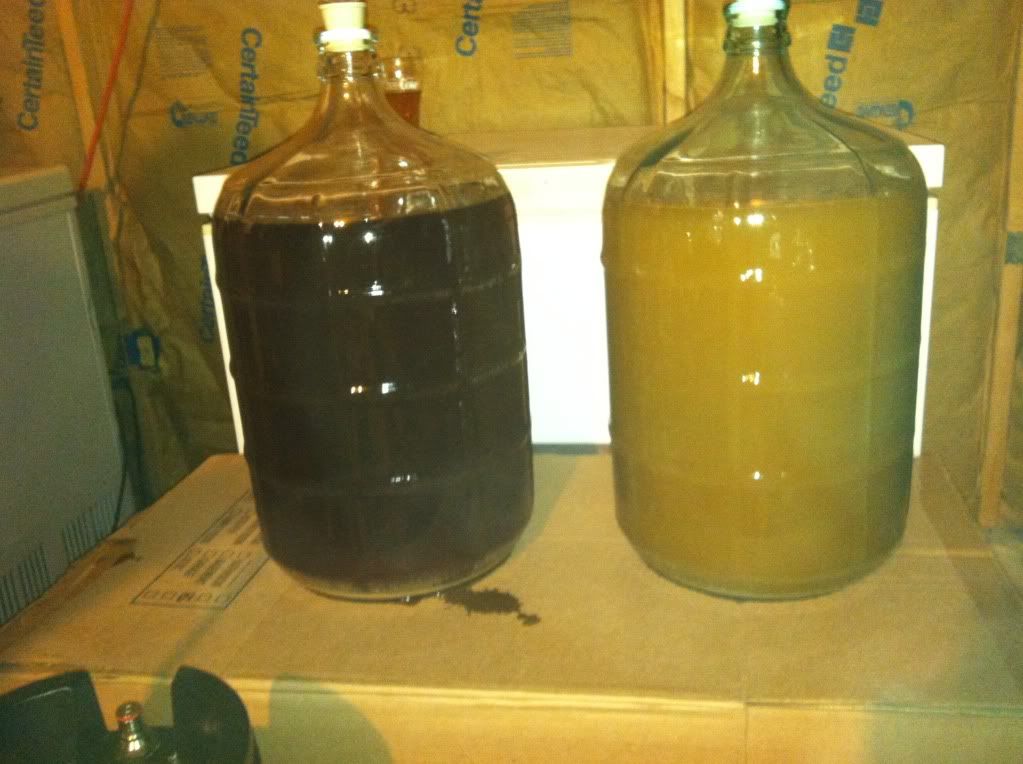EdK
Well-Known Member
Reposting from my thread over on BeerAdvocate. Hopefully this is in the right section...
Maibock - 10 gallons
Brewed 1/22 - brewed together in one vessel
Secondary for lagering 2/26 - split in two carboys
Kegged 5/6/2012
15 lbs. Pilsen
10 lbs. Pale Ale
1 lb. Carahell
Single infusion - 152
2 oz. Perle (60)
2 oz. Hersbrucker (60)
2 oz. Hersbrucker (15)
Wyeast 2124 Bohemian Lager
OG 1070
FG 1014
Notes - We did have some mash temp problems (heating element/recirculating failure) and to raise the temp up we did some what of an impromptu decoct, removing grain and boiling - the mash tun was too full to add water. We did wind up hitting the temp, but I assume it mashed at a lower temp longer.
All 10 gallons was fermented together in a converted half keg and then split into two carboys for lagering. It was finally time to keg yesterday, and this is what we found -

Yes, same beer. And they taste pretty much the same, except - and maybe this is in my head - for a slight twang I can't place at the moment, with the cloudy one having it more so. Of course, in a tasting glass, they are closer in color but the cloudiness is still aparent. The darker one on the left was basically crystal clear, while the other looked more like some sort of hefe with it's cloudiness.
These have been sitting for like 3 months lagering. We kegged anyway.
Suspended yeast came to mind - or some sort of chill haze. But why one and not the other - especially after nearly 3 months? Like I said they did not ferment separately, just lagered separately. It was all one batch fermented together in one vessel.
I was not there for the transfer from primary to secondary but could a scenario were the beer that was split into the two carboys had some sort of difference from the top to the bottom? So for instance, the first carboy filled would be drawing directly from the bottom, while the second would be drawing from what was left which was originally on the top.
Side Note - Earlier that day, I had also unhooked the temperature probe (for brewing) from the freezer and plugged the freezer back in - which was dropping to freezing temperatures until we racked later that day.
Anybody know what's going on here?
Maibock - 10 gallons
Brewed 1/22 - brewed together in one vessel
Secondary for lagering 2/26 - split in two carboys
Kegged 5/6/2012
15 lbs. Pilsen
10 lbs. Pale Ale
1 lb. Carahell
Single infusion - 152
2 oz. Perle (60)
2 oz. Hersbrucker (60)
2 oz. Hersbrucker (15)
Wyeast 2124 Bohemian Lager
OG 1070
FG 1014
Notes - We did have some mash temp problems (heating element/recirculating failure) and to raise the temp up we did some what of an impromptu decoct, removing grain and boiling - the mash tun was too full to add water. We did wind up hitting the temp, but I assume it mashed at a lower temp longer.
All 10 gallons was fermented together in a converted half keg and then split into two carboys for lagering. It was finally time to keg yesterday, and this is what we found -

Yes, same beer. And they taste pretty much the same, except - and maybe this is in my head - for a slight twang I can't place at the moment, with the cloudy one having it more so. Of course, in a tasting glass, they are closer in color but the cloudiness is still aparent. The darker one on the left was basically crystal clear, while the other looked more like some sort of hefe with it's cloudiness.
These have been sitting for like 3 months lagering. We kegged anyway.
Suspended yeast came to mind - or some sort of chill haze. But why one and not the other - especially after nearly 3 months? Like I said they did not ferment separately, just lagered separately. It was all one batch fermented together in one vessel.
I was not there for the transfer from primary to secondary but could a scenario were the beer that was split into the two carboys had some sort of difference from the top to the bottom? So for instance, the first carboy filled would be drawing directly from the bottom, while the second would be drawing from what was left which was originally on the top.
Side Note - Earlier that day, I had also unhooked the temperature probe (for brewing) from the freezer and plugged the freezer back in - which was dropping to freezing temperatures until we racked later that day.
Anybody know what's going on here?


